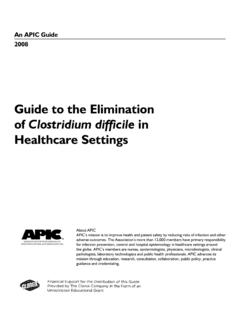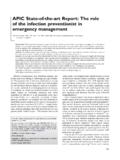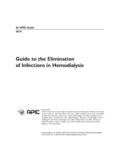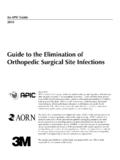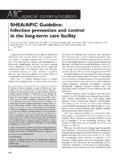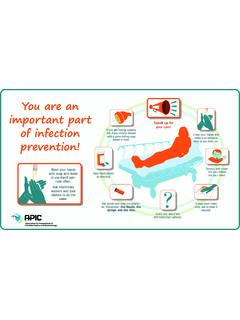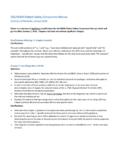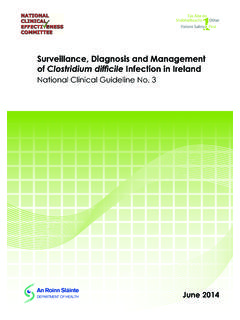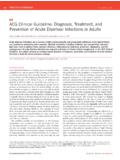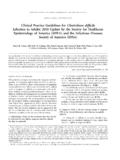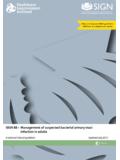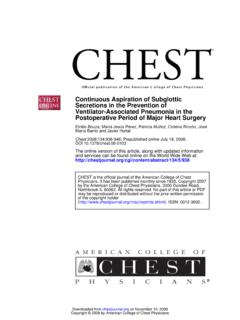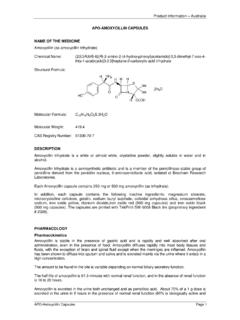Transcription of Guide to the Elimination of Ventilator-Associated Pneumonia
1 An APIC Guide 2009. Guide to the Elimination of Ventilator-Associated Pneumonia About APIC. APIC's mission is to improve health and patient safety by reducing risks of infection and other adverse outcomes. The Association's more than 12,000 members have primary responsibility for infection prevention, control and hospital epidemiology in healthcare settings around the globe. APIC's members are nurses, epidemiologists, physicians, microbiologists, clinical pathologists, laboratory technologists and public health professionals. APIC advances its mission through education, research, consultation, collaboration, public policy, practice guidance and credentialing. Financial Support for the Distribution of this Guide Provided by Smiths Medical in the Form of an Unrestricted Educational Grant For additional resources, please visit Look for other topics in APIC's Elimination Guide Series, including: Catheter-Related Bloodstream Infections Catheter-Related Urinary Tract Infections Clostridium difficile Mediastinitis MRSA in Long-Term Care Copyright 2009 by APIC.
2 All rights reserved. No part of this publication may be reproduced, stored in a retrieval system, or transmitted, in any form or by any means, electronic, mechanical, photocopying, recording, or otherwise, without prior written permission of the publisher. All inquires about this document or other APIC products and services may be addressed to: APIC Headquarters 1275 K Street, NW. Suite 1000. Washington, DC 20005. Phone: Email: Web: ISBN: 1-933013-43-5. Guide to the Elimination of Ventilator-Associated Pneumonia Table of Contents 1. Acknowledgments.. 4. 2. Conflict of Interest .. 5. 3. Guide Overview.. 6. 4. Problem Identification .. 9. 5. Surveillance Definitions .. 16. 6. Risk Assessment.. 21. 7. Surveillance Plan.
3 28. 8. Prevention Strategies .. 33. 9. Putting It All Together.. 42. ASSOCIATION FOR PROFESSIONALS IN INFECTION CONTROL AND EPIDEMIOLOGY 3. Guide to the Elimination of Ventilator-Associated Pneumonia Acknowledgments APIC acknowledges the valuable contributions of the following individuals: Authors Linda R. Greene, RN, MPS, CIC. Director of Infection Prevention Rochester General Health System Rochester, NY. Kathleen Sposato, RN, BSN, CIC. Director, Infection Prevention and Control Glens Falls Hospital Glens Falls, NY. Reviewers Michelle R. Farber, RN, CIC. Infection Control Specialist Mercy Community Hospital Coon Rapids, MN. Teresa M. Fulton, RN, MSN, CIC, CNLCP. Director, Quality and Patient Safety Whidbey General Hospital Coupeville, WA.
4 Robert A. Garcia, BS, MT(ASCP), CIC. President and CEO. Enhanced Epidemiology Valley Stream, NY. 4 ASSOCIATION FOR PROFESSIONALS IN INFECTION CONTROL AND EPIDEMIOLOGY. Guide to the Elimination of Ventilator-Associated Pneumonia Conflict of Interest Authors and reviewers of this Guide were asked to complete an APIC Conflict-of-Interest Disclosure Statement. Linda R. Greene, RN, MPS, CIC has nothing to disclose. Kathleen Sposato, RN, BSN, CIC has nothing to disclose. Michelle R. Farber, RN, CIC has nothing to disclose. Robert A. Garcia, BS, MT(ASCP), CIC has nothing to disclose. Teresa M. Fulton, RN, MSN, CIC, CNLCP serves on I-Flow corporate speakers bureau. ASSOCIATION FOR PROFESSIONALS IN INFECTION CONTROL AND EPIDEMIOLOGY 5.
5 Guide to the Elimination of Ventilator-Associated Pneumonia Guide Overview The purpose of this Guide is to provide evidence-based practice guidelines for the Elimination of ventilator- associated Pneumonia (VAP). Pneumonia accounts for approximately 11% to 15% of all hospital-associated infections (HAIs) and 27% and 24%. of all infections acquired in the medical intensive care unit (MICU) and coronary care unit (CCU), The primary risk factor for the development of hospital-associated bacterial Pneumonia is mechanical ventilation (with its requisite endotracheal intubation). Rates of VAP vary depending on the type of ICU, and may range from zero to 16 per 1000 ventilator days. Highest rates were identified in trauma ICUs, as reported in the 2008 National Healthcare Safety Network (NHSN) The VAP Infection Prevention and Control Program An effective facility-wide infection prevention and control program is comprised of many components and interventions that can reduce the risk of VAP in acutely ill patients.
6 This Guide will provide strategies and tools that can be used for VAP prevention. Recent quality improvement initiatives suggest that many cases of VAP might be prevented by careful attention to the process of care. The successful management of patients on ventilators is necessary to ensure the best possible outcomes for individual patients while reducing the morbidity and mortality associated with these infections. Components of a Successful Program Accountability for VAP prevention activities is outlined in the 2008 Strategies to Prevent Ventilator-Associated Pneumonia in Acute Care Hospitals and is outlined 1. Th e hospital's chief executive officer and senior management are responsible for ensuring that the healthcare system supports an infection prevention and control program to effectively prevent VAP.
7 2. S. enior management is accountable for ensuring that an adequate number of trained personnel are assigned to the infection prevention and control program. 3. S. enior management is accountable for ensuring that healthcare personnel, including licensed and nonlicensed personnel, are competent to perform their job responsibilities. 4. D. irect healthcare providers ( , physicians, nurses, aides, and therapists) and ancillary personnel ( , environmental services and equipment processing personnel) are responsible for ensuring that appropriate infection prevention and control practices are used at all times (including hand hygiene, standard and transmission-based or expanded precautions, cleaning and disinfection of equipment and the environment, aseptic technique when suctioning secretions and handling respiratory therapy equipment, patient positioning, sedation and weaning protocols, and oral care).
8 5. H. ospital and unit leaders are responsible for ensuring that personnel are accountable for their actions. 6. Th e person who manages the infection prevention and control program is responsible for ensuring that an active program to identify VAP is implemented, that data on VAP are analyzed and regularly provided to those who can use the information to improve the quality of care ( , unit staff, clinicians, and hospital administrators), and that evidence-based practices are incorporated into the program. 7. H. ealthcare personnel are accountable for ensuring that appropriate training and educational programs to prevent VAP are developed and provided to medical staff, patients, and families. 6 ASSOCIATION FOR PROFESSIONALS IN INFECTION CONTROL AND EPIDEMIOLOGY.
9 Guide to the Elimination of Ventilator-Associated Pneumonia The role of the infection preventionist in the effort to reduce the incidence of VAP includes policy and best practice subject matter expertise, provision of surveillance data and risk assessment, consultation on infection prevention interventions, and facilitation of VAP-related improvement projects. It is important that the infection preventionist communicates and networks with all members of the patient care team regarding VAP-related infection prevention. Providing subject matter expertise to those involved with clinical management of the patients, including physicians, physician assistants, and nurse practitioners, is essential. An understanding of the elements of surveillance definitions compared with clinical definitions is important.
10 Anesthesiologists, respiratory care, hospitalists, emergency department physicians, and medical residents are examples of individuals involved in intubation. Nursing staff and other members of the healthcare team are responsible for care of the patient on a ventilator. Therefore, success of a prevention project requires that these personnel are fully engaged and committed to this important patient safety initiative. Obtaining the resources that will engage direct care providers in the VAP quality/performance improvement activities is a critical component of intervention development. Key players must be held accountable for compliance with the prevention strategies and interventions. This can be facilitated through monitoring and reporting of the results of the intervention on a consistent basis, and instituting additional improvements when appropriate.
